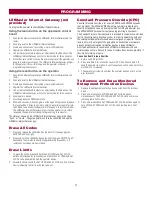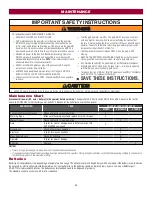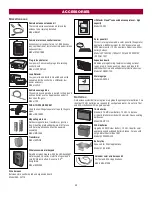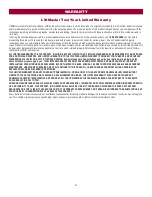
39
SYMPTOM
POSSIBLE CAUSES
SOLUTIONS
Gate opens, but
will not close with
transmitter or
Timer-to-Close.
a. Open control active
b. Vehicle loop detector active
c. Fire Dept input active
d. Timer-to-Close not set
e. Close Entrapment Protection Device active
a. Check all Open inputs for an active input
b. Check all vehicle detector inputs for an active detector
c. Check AC power and AC Fail option setting
d. Check if AC power is available. If no AC power, then running on
batteries and battery voltage must be 23.0 Vdc or higher. Charge
batteries by AC or solar power or replace batteries.
e. Check Fire Dept input
f. Check Timer-to-Close (TTC) setting
g. Check all Entrapment Protection Device inputs for an active sensor
Gate closes, but
will not open.
a. Vehicle loop detector active
b. Low battery with LOW BATT option set to
CLOSE
a. Check all vehicle detector inputs for an active detector
b. Check if AC power is available. If no AC power, then running on
batteries and battery voltage must be 23.0 Vdc or higher. Charge
batteries by AC or solar power or replace batteries.
Exit loop activation
does not cause
gate to open.
a. Exit vehicle detector setup incorrectly
b. Defective Exit loop detector
c. Low battery with LOW BATT option set to
CLOSE
a. Review Exit loop detector settings. Adjust settings as needed.
b. Replace defective Exit loop detector.
c. Check if AC power is available. If no AC power, then running on
batteries and battery voltage must be 23.0 Vdc or higher. Charge
batteries by AC or solar power or replace batteries.
Interrupt loop does
not cause gate to
stop and reverse.
a. Vehicle detector setup incorrectly
b. Defective vehicle loop detector
a. Review Interrupt loop detector settings. Adjust settings as needed.
b. Replace defective Interrupt loop detector.
Shadow loop does
not keep gate at
open limit.
a. Vehicle detector setup incorrectly
b. Defective vehicle loop detector
a. Review Shadow loop detector settings. Adjust settings as needed.
b. Replace defective Shadow loop detector.
Obstruction in
gate's path does
not cause gate to
stop and reverse.
a. Force adjustment needed
a. Refer to the Adjustment section to conduct the obstruction test and
perform the proper force adjustment that is needed.
Photoelectric
sensor does not
stop or reverse
gate.
a. Incorrect photoelectric sensor wiring
b. Defective photoelectric sensor
a. Check photoelectric sensor wiring. Retest that obstructing photoelectric
sensor causes moving gate to stop, and may reverse direction.
b. Replace defective photoelectric sensor. Retest that obstructing
photoelectric sensor causes moving gate to stop, and may reverse
direction.
Edge Sensor does
not stop or reverse
gate.
a. Incorrect edge sensor wiring
b. Defective edge sensor
a. Check edge sensor wiring. Retest that activating edge sensor causes
moving gate to stop and reverse direction.
b. Replace defective edge sensor. Retest that activating edge sensor causes
moving gate to stop and reverse direction.
Alarm sounds for 5
minutes or alarm
sounds with a
command.
a. Double entrapment occurred (two
obstructions within a single activation)
a. Check for cause of entrapment (obstruction) detection and correct. Press
the reset button to shut off alarm and reset the operator.
Alarm beeps three
times with a
command.
a. Low battery
a. Check if AC power is available. If no AC power, then running on
batteries and battery voltage must be 23.0 Vdc or higher. Charge
batteries by AC or solar power or replace batteries
On dual-gate
system, incorrect
gate opens first or
closes first.
a. Incorrect Bipart switch setting
a. Change setting of both operator’s Bipart switch settings. One operator
should have Bipart switch ON (operator that opens second) and the other
operator should have Bipart switch OFF (operator that opens first).
Alarm beeps when
running.
a. Expansion board setting
b. Constant pressure to open or close is given
a. Pre-warning is set to "ON"
b. Constant pressure to open or closed is given
TROUBLESHOOTING














































